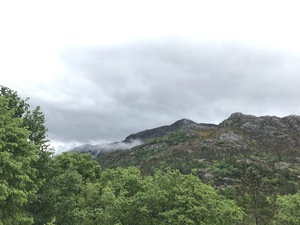
Live stream: mobile_geres_biosphere.ogg
Gerês Biosphere Reserve, Portugal
Cláudia Martinho
Latitude: +41.761133°
Longitude: -8.192593°
I’ve been recording in Gerês mountains, forests and rivers since I moved here, 3 years ago. The location is inside Geres-Xures UNESCO Transboundary Biosphere Reserve, part of the National Park Peneda-Geres, with a large wilderness area.
Streaming from my garden, surrounded by oak trees, located between granite mountains, in the outskirts of a small village, Campo do Gerês, near a forest, Mata da Albergaria. Sounds from birds, insects, cattle, rural activities, a road and a river nearby. The location is inside Geres-Xures Biosphere Reserve, part of the National Park Peneda-Geres.
The Park was created in 8 May 1971 due to its scientific and ecological interest, with the aim to protect soils, water, flora, fauna, and landscapes within the vast mountainous region in the northwest of Portugal. In 1997, Peneda-Geres was included in the Natura 2000 network, and in 1999, designated a Special Protection Area for Wild Birds. Moreover, it also encompasses an important area of native forest, which forms part of the European Network of Biogenetic Reserves. This hilly landscape is far from major population centres, with a dense hydrographic network, ecosystems in a good state of conservation, fauna and flora species of exceptional interest for the conservation of biodiversity. Inherited pre-and proto-historical agricultural and pasture techniques and communitarian practices have ensured a balance between human activity and the natural environment. For its natural and cultural values the area was declared a Biosphere Reserve by UNESCO in 27 May 2009.
Biomass coverage of the Geres mountains and plateaus are dominated by four distinct biomes: oak forest, shrubbery, marshes and riparian vegetation. The flora diversity includes 823 vascular taxa that occur in 128 types of vegetation. The forests area of Matas de Albergaria/Palheiros is considered as the heart of the park. Approximately 235 vertebrate species were identified, of which 200 are threatened or under protection (these include the Iberian wolf, three species of bat, the golden eagle, the Geres goat). 147 species of birds are identified, many of which are migratory, with approximately 36 species nesting in the area. Of particular note are the red-billed Chough, Golden Owl, European honey buzzard (Pernis apivorus), hen harrier (Circus cyaneus), common snipe (Gallinago gallinago), red-backed shrike (Lanius collurio), yellowhammer (Emberiza citrinella), garden warbler (Sylvia borin) and whinchat (Saxicola rubetra).
The Park was created in 8 May 1971 due to its scientific and ecological interest, with the aim to protect soils, water, flora, fauna, and landscapes within the vast mountainous region in the northwest of Portugal. In 1997, Peneda-Geres was included in the Natura 2000 network, and in 1999, designated a Special Protection Area for Wild Birds. Moreover, it also encompasses an important area of native forest, which forms part of the European Network of Biogenetic Reserves. This hilly landscape is far from major population centres, with a dense hydrographic network, ecosystems in a good state of conservation, fauna and flora species of exceptional interest for the conservation of biodiversity. Inherited pre-and proto-historical agricultural and pasture techniques and communitarian practices have ensured a balance between human activity and the natural environment. For its natural and cultural values the area was declared a Biosphere Reserve by UNESCO in 27 May 2009.
Biomass coverage of the Geres mountains and plateaus are dominated by four distinct biomes: oak forest, shrubbery, marshes and riparian vegetation. The flora diversity includes 823 vascular taxa that occur in 128 types of vegetation. The forests area of Matas de Albergaria/Palheiros is considered as the heart of the park. Approximately 235 vertebrate species were identified, of which 200 are threatened or under protection (these include the Iberian wolf, three species of bat, the golden eagle, the Geres goat). 147 species of birds are identified, many of which are migratory, with approximately 36 species nesting in the area. Of particular note are the red-billed Chough, Golden Owl, European honey buzzard (Pernis apivorus), hen harrier (Circus cyaneus), common snipe (Gallinago gallinago), red-backed shrike (Lanius collurio), yellowhammer (Emberiza citrinella), garden warbler (Sylvia borin) and whinchat (Saxicola rubetra).